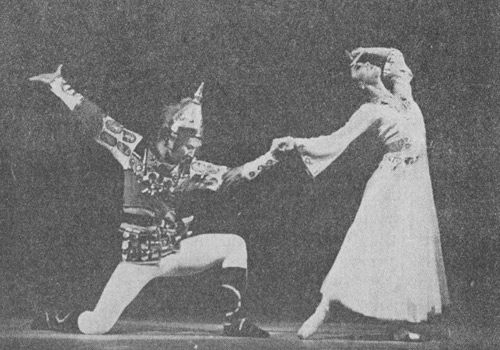| The Central Ballet Troupe's new productions Lin Daiyu and The General Bids His Lady Farewell have been enthusiastically received by Beijing audiences since they opened last December. These ballets successfully transform episodes from a classic novel and a Peking Opera into dance movements.
Lin Daiyu is an episode from the 18th century novel A Dream of Red Mansions; the ballet depicts the tragic love story of Lin Daiyu and her cousin Jia Baoyu.
In the book, Lin Daiyu is the tragic heroine, beautiful, talented, full of love, but too proud. After the death of her mother, she is raised in her uncle's home. She and Jia Baoyu, her cousin, have contempt for those who study hard to gain high positions in the feudal court. They fall in love, but the Jia family opposes this partnership and force Jia Baoyu to marry Xue Baochai.
 |
|
A scene from The General Bids His Lady Farewell |
The ballet focuses on the climax of the story. It depicts how Lin Daiyu, at the last moment of her life, remembers the romance, its happiness and sadness.
"I sought to create both ballet and poetry," said choreographer Li Chengxiang. In Lin Daiyu's solo dance and the pas de deux of Lin Daiyu and Jia Baoyu, Lin Daiyu's sorrow and loneliness and the love between Lin Daiyu and Jia Baoyu are portrayed with defined and graceful dance movements and modelling. The trio performance of Jia Baoyu, Lin Daiyu and Xue Baochai masterfully intertwines the tragedies of the three.
If Lin Daiyu is a tragic poem, then The General Bids His Lady Farewell is a solemn song.
In the Peking Opera version of the story, the armies of Xiang Yu, a brave yet less resourceful general of 200 B.C., are being defeated. When the general is leaving for the last-ditch battle, his lady performs a sword dance for him and then kills herself to bolster his determination.
Based on his study of historical material, the choreographer Niu Deli eliminated the sword dance. However, he does utilize some aspects of operatic style.
The dance Drinking With Sorrow unfolds the general's rough manner and heroism and the lady's grace and tenderness. The hero's strength, ambition and deep love for his lady are manifested in lifts and bold movements.
The creation of ballets based on centuries-old stories is a promising development of Chinese choreography. Chinese ballet only has a relatively short history; these new productions are among the growing number of pieces it can call its own. | 